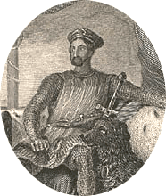|
|
Home | Corson Collection | Biography | Works | Image Collection | Recent Publications | Portraits | Correspondence | Forthcoming Events | Links | E-Texts | Contact Count Robert of Paris(Tales of My Landlord, Fourth Series)First Edition, First Impression: Tales of My Landlord, Fourth and Last Series. Collected and Arranged by Jedediah Cleishbotham, Schoolmaster and Parish-Clerk of Gandercleuch. In Four Volumes. Vol. I (II-IV). Printed for Robert Cadell, Edinburgh; and Whittaker and Co., London, 1832. Composition | Synopsis | Reception | Links Composition
SynopsisCount Robert is set during the reign of the Byzantine Emperor Alexius Comnenus (1081-1118) and focuses on the arrival of the first Crusaders in 1096. During the oath-taking ceremony on the eve of the Crusade, the haughty Count Robert insults the Emperor by seating himself on the imperial throne. Also offended is Robert's friend Hereward, a Saxon member of the Varangian guard, exiled from England after the Norman Conquest. When the Crusaders leave Byzance for Asia, Robert is drugged and detained as captive. His Amazonian wife, Brenhilda is held separately and persecuted by the enamoured Nicephorus Briennus, the emperor's son-in-law. Brenhilda challenges Nicephorus to combat, promising to give herself to him if defeated. In the meantime, Robert is freed by Hereward, and presents himself at the duel in his wife's stead. Nicephorus, though, does not appear as he has been arrested following the discovery of a plot to usurp Alexius. Still keen to avenge Robert's affront to the Emperor, Hereward takes his place. Robert defeats him but spares his life in gratitude for his earlier help. Hereward follows Robert to Palestine as a vassal, after discovering that his lost Saxon love Bertha is Brenhilda's waiting-woman. Through Robert's influence, a portion of Hereward's English property is restored to him.
ReceptionSales were strong, but the critics were slow to review the new volume. Most were uneffusive but respectful, with only the Gentleman's Magazine considering it an unqualified success, and only the Monthly Review branding it 'an unfortunate production'. The Edinburgh Literary Journal summed up the thoughts of many critics and non-professional readers, judging that the two novels 'must rank among the least successful of Sir Walter's works, and yet they bear about them sufficient traces of his genius to redeem them from absolute failure, even were they not his farewell gift to the public'. LinksLast updated: 19-Dec-2011 |
|

 It
was around February 1826, in the middle of writing
It
was around February 1826, in the middle of writing
